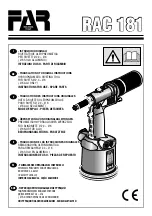
8
DRILLING POCKET HOLES
Selecting the correct bushing to use:
The bushings on the drill guides are intended for different size materials.
You can determine which bushings to use by looking at the correspond-
ing printed markings on the side of the drill guides.
• For materials 1-1/4 in. and 1-1/2 in. thick, use the bushings closest to
the drill guide locking knob (Fig. 5 - 1).
• For materials 1/2 in., 3/4 in., or 1 in. thick use the bushings that are
nearest to the toggle clamp (Fig. 5 - 2).
Drilling 1/2 in. material:
To correctly drill 1/2 in. material, you must utilize the 1/2 in. elevation
screws.
1. Screw the two elevation screws (Fig. 6a - 1) into the lower face of the
drill guides.
2. Rest the workpiece on top of the elevation screws before performing
the “Setting Up Your Workpiece” steps o
n p. 7.
NOTE:
If the elevation screws are not in place when drilling into 1/2 in.
materials, the holes will not be aligned correctly, leading to workpieces
not secured properly.
NOTE:
When not using the elevation screws, store them in the holes be-
tween the two mounting holes (Fig. 6b).
Using the depth collar:
Pocket holes should not go all the way through the workpiece. To stop the
drill bit from going through the workpiece, utilize the depth collar.
1. Place the depth collar (Fig. 7 - 1) onto the step drill bit (Fig. 7 - 2) and
adjust the drilling depth by changing the position of the depth collar on
the shank of the drill bit.
2. Once the drill depth has been determined, secure the depth collar by
tightening the set screw (Fig. 7 - 3) on the side with the included 2.5mm
hex wrench.
NOTE:
Before drilling the pocket hole, test to ensure that the drill bit will
not drill into the base of the jig.
OPERATION
Fig. 5
2
1
1
2
Fig. 6a
Fig. 6b
Fig. 7
1
Step
1
2
3
Drilling into the workpiece:
1. Place the step drill bit, with the depth collar attached, into a drill (not
included) and tighten the drill chuck firmly.
2. Without turning the drill on, place the drill bit into the correct drill guide bushing. Without engaging the work-
piece, power the drill up to full speed and then slowly drill into the workpiece until the depth collar reaches the top
of the drill guide bushings.
3. Release the drill trigger, remove from the bushing, and repeat the above steps as needed. Run the drill in reverse
to back the bit out of the workpiece if needed.






























